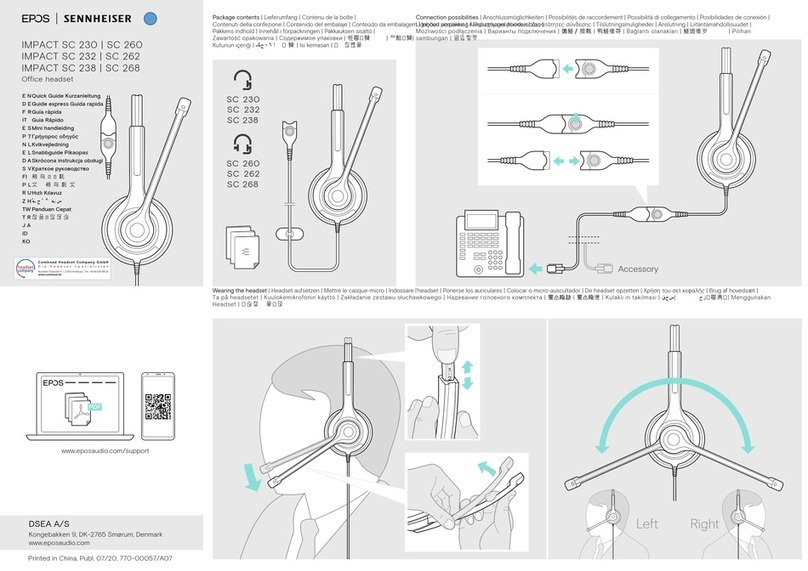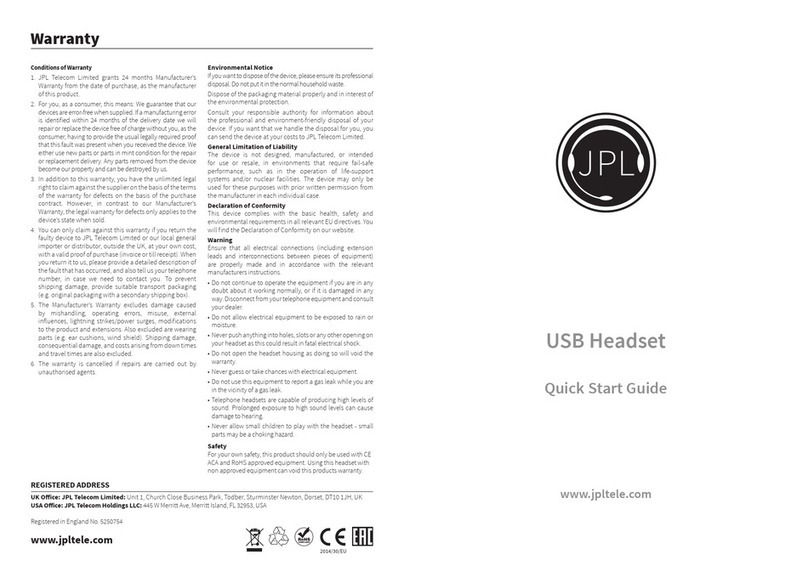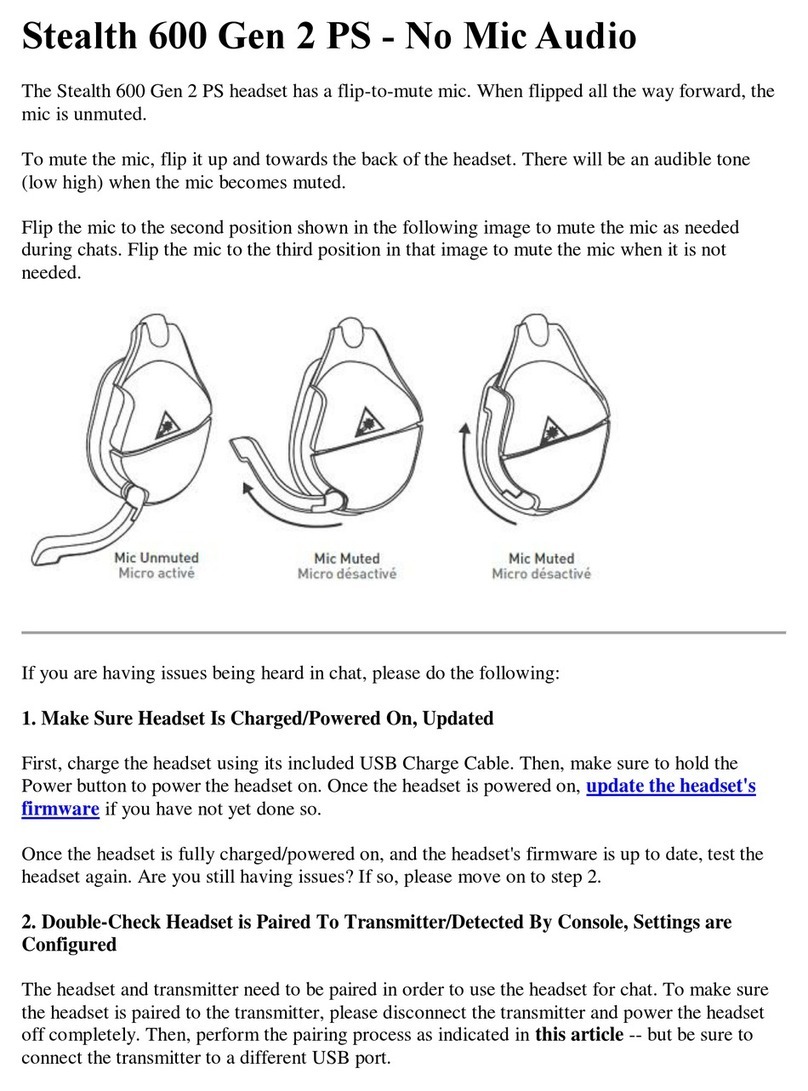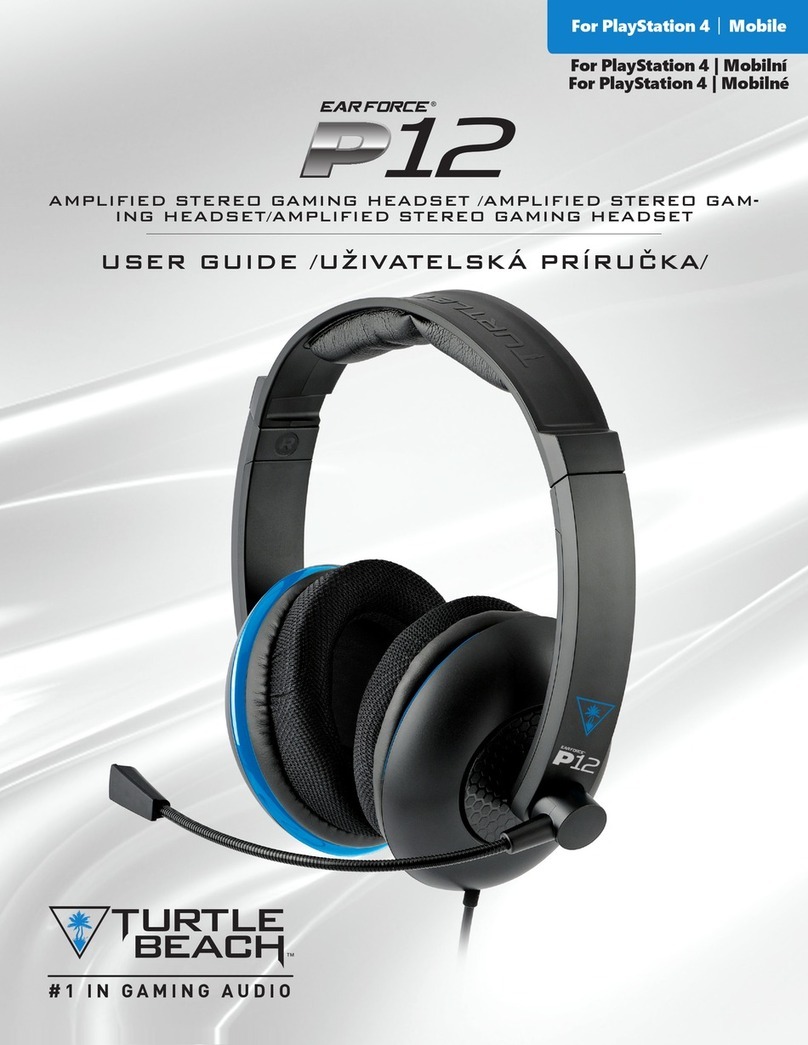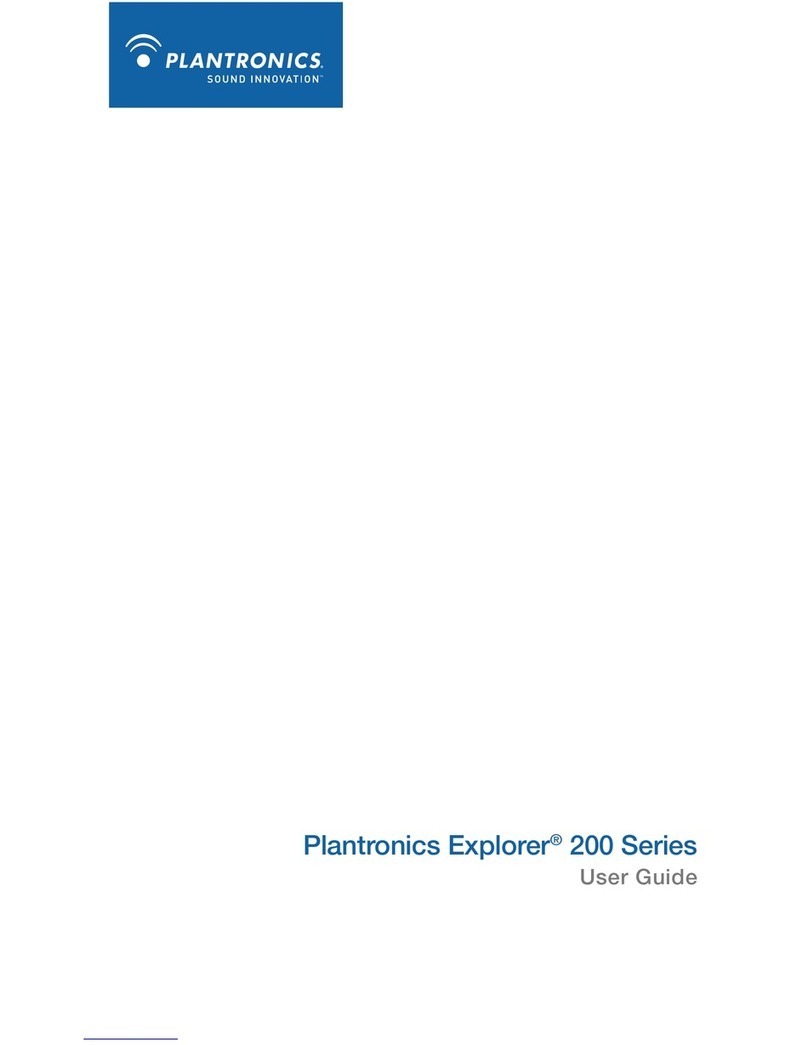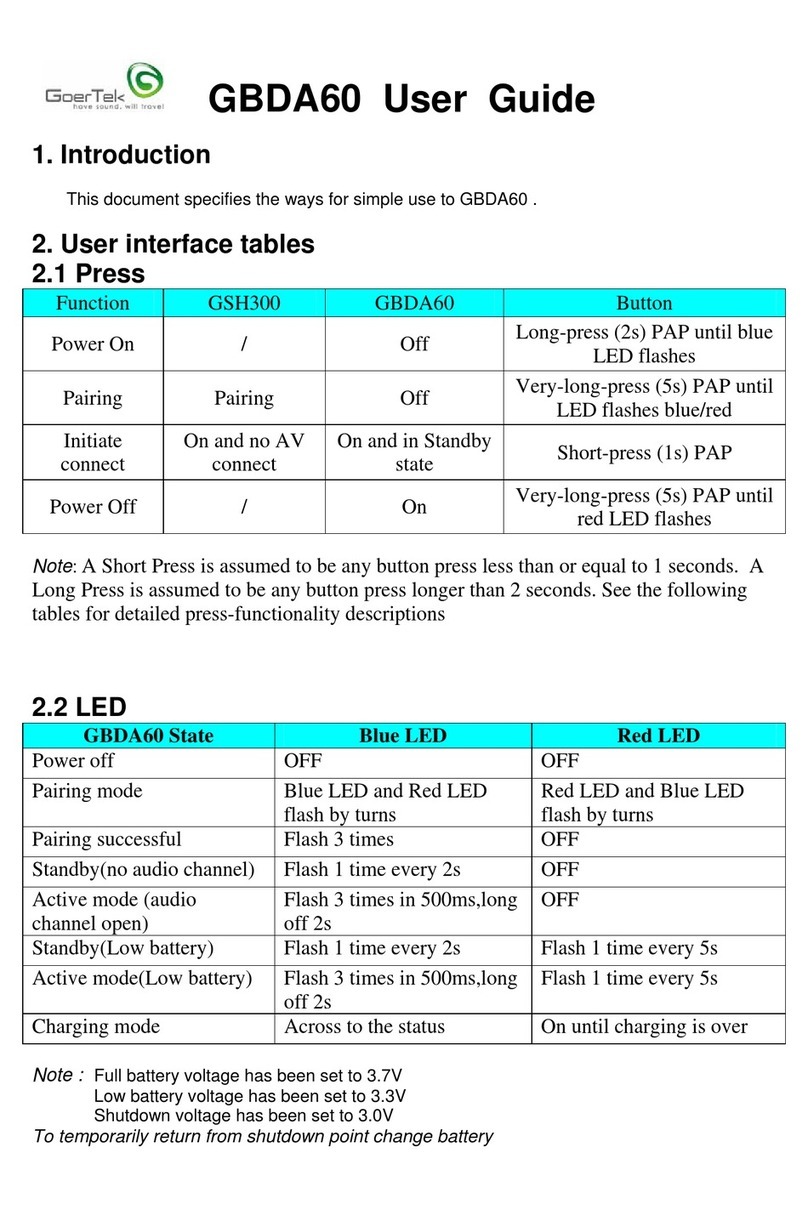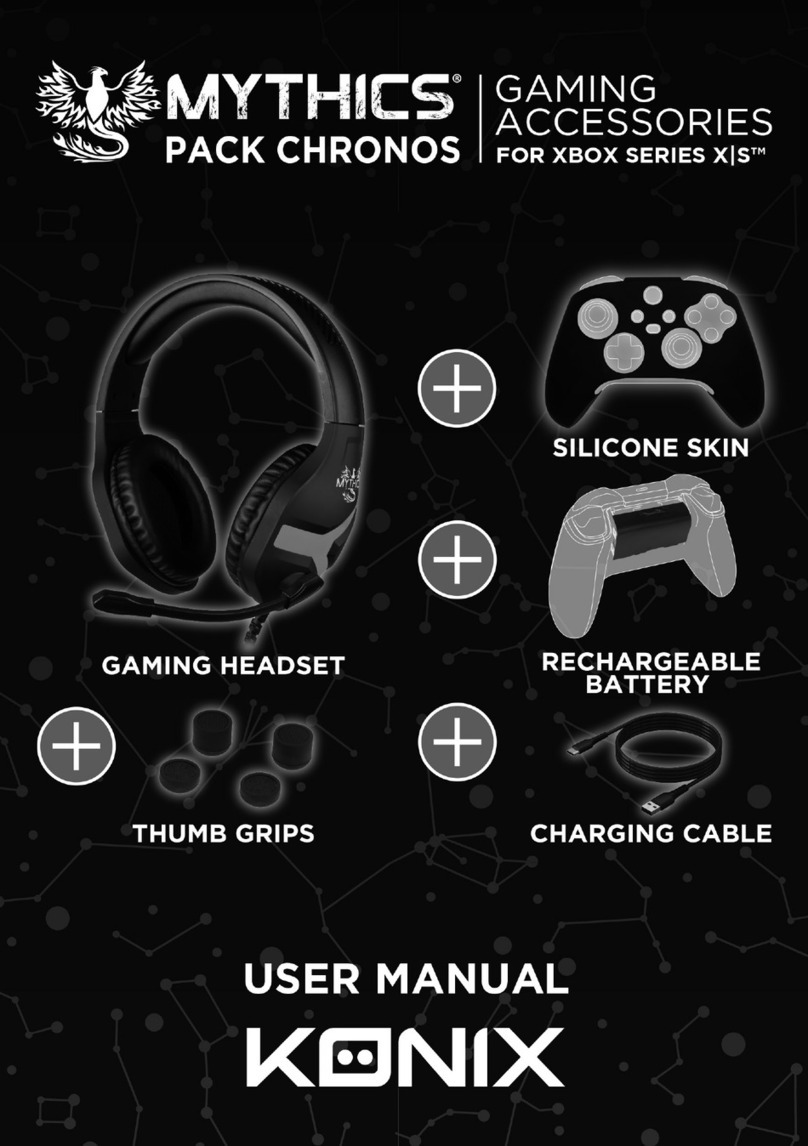HCS 460C User manual

Private Address Wireless Network
Two Way Communications for Extreme
Noise Environment
MODEL 460C
OPERATING MANUAL
Thank you for buying this HCS transceiver.
This instruction manual contains important safety and operating instruction.Please read it carefully before using the Headset.
HEAD CONNECTION SYSTEMS LTd.
112 Soundview Drive, Port Washington
NY, 11050 –1750 Fax: (516) 944-7556
For Extreme Noise Environment
HCS Head Connection Systems Ltd.

2
1. Model-460Cwas tested and approved according the FCC part 90 for Programmable
UHF commercial licence -FCC ID: M5U-101-460C
GENERAL DESCRIPTION
Two-way Programmable radio headsets (earmuffs),up to 4 frequencies, UHF (450-470MHz)
transceiver, Ni-HM rechargeable battery operated, built into a highly efficient hearing protection
for secure voice communications in noisy environments. Built in connector for Sell-phone /
music plug or frequencies program cable.
FUNCTIONALITY
Enables wireless communication between all headsets and with an optional base-station on
common frequencies. The noise-suppressing microphone efficiently reduces background noise.
The headset microphone and speakers are used simultaneously with a connected cellular phone.
Transmission can be initiated by manually push-to-talk or hands free VOX system.
APPLICATIONS
The applications for PAWN are many; Shop floors, Power plants, Forestry, Construction sites,
Quarries, Recreational areas and other noisy areas where secure communication over short
distances are essential. The plug-in sell-phone enables clear communication with the outside
world.
OPERATING INSTRUCTIONS
Simplified controls make PAWN Headsets easy to use. A four-position switch selects the
operating mode, either VOX /PTT or PTT. Rotary switch controls On/Off/Volume.
2. PRODUCT LAYOUT
1. PTT -”talk” button for manual transmission
2. Program /cell phone Plug-in.
3. 4-way switch-VOX/PTT setting with three
alternatives for adjusting VOXcircuit’s
sensitivity, to ensure "Hands-Free" correct
microphone activation in relation to external noise
levels. The PTT position, is activated via the
”talk” button.
4. Volume On/Off control for adjusting the
volume level in the headset.
5. Frequency setting, -Two -position pre-set
channels.
6. Charging socket.
1
3
2
5
4
6

3
3. Transmitting and receiving:
The headset is in receiving mode, when turned ON by the Volume/ On/Off switch.
To transmit voice, make sure that the microphone is very close to your mouth (about ½ “) and
the white dot on the microphone is against your mouth.
Push the PTT button or adjust the VOX sensitivity and start talking.
After releasing the PTT or when you stop talking in VOX mode, you and all other recipients will
hear a beep tone-to confirm end of transmission.
4. Adjustment of the VOX sensitivity:
A. Maximum sensitivity(first VOX level -opposite to the PTT position) is appropriate for
communication in low noise levels -up to 92dB(A).
B. Medium sensitivity starts the VOX with this position. Suitable for most noisy area up to
105dB(A).
C. Minimum sensitivity (lowest sensitivity-position close to the PTT position) is
appropriate for transmissions in high noise levels (up to 130dB and requires an increased
voice signal in order to activate the transmitter.
Note: When transmitting, you should hear your own voice through the speakers.
5. Suggestions for proper operation:
A. It is recommended to use the PTT to transmit if you have a free hand..
B. When using VOX mode, speak continuously and avoid silent periods between words.
C. When you receive a transmission, the PAWN blocks VOX transmission, PTT is always
available.
6. Should the transmitter not work properly in VOX mode check the following:
A. Is the VOX sensitivity position is right for the noise surrounding you?
B. Is the microphone positioned close enough to your mouth?
C. Are you speaking loudly enough?
D. Is the other user transmitting, or is the VOX sensitivity set so high that the transmitter
is constantly activated?
7. CTCSS tone (PL Decoder/Encoder) considerations:
A. The default internal dip switch position (see page 6) is OFF.
B. If you experience interference on the selected channel, it is recommended to change the
channel. If you must stay on the first channel, you move the CTCSS dip switch to ON.
C. Please note:
D. If you are using the VOX system with PL, expect a longer delay between beginning of
speech and transmission than by using PTT. The recessives will have a delay of 1-2
seconds. There for you must extend the first word like -DDDDDDave, listen…..
E. Every body must change to CTCSS ON in order for this feature to work because it affects
all channels.

4
8. BATTERY MAINTENANCE AND CHARGING PROCEDURE
Important: Before first use charge the battery for 15 hours.
Always charge with power turned off.
To save battery power, the unit is programmed to self shut-off within 60 min. if no activity,
receiving or transmitting is detected. A chirp tone will be heard 30 second before shutdown.
When the battery is almost empty, A number of alert short tone beep will be heard before
shutdown, and the red LED light will blink.
Important:For best functionality, remove hair around the ears from under the cushions to
improve the acoustical seal against the head. Eyeglass temples should be as thin as possible and
conform close to the head. Turn on the headset and adjust the volume for best listening level.
10. HEADSET MAINTENANCE AND USER INFORMATION
In order to fully benefit from the superior noise attenuation, wear PAWN 100% of the time you
are exposed to noise!
Regularly clean the outside of PAWN using warm water and a mild detergent.
WARNING:The unit must not be submerged in water.
Do not store or place PAWN in temperatures exceeding +55 C (13O F). Do not place the unit
behind a car windshield or in direct sunlight.
Certain chemicals may negatively effect this product. The manufacturer can provide further
information.
PAWN and especially the cushions may degrade over time and should be examined regularly to
verify that they are not cracked or otherwise damaged. Replacement cushions are available. For
cushion replacement just pull off the old ones and snap in the new cushions.
Important-If these instructions are not followed properly, the noise attenuation properties and
functionality of the unit may be negatively affected.

5
11. TECHNICAL SPECIFICATIONS
Operating Distance: Approx. 1800 m (6000 ft) over level terrain.
500 -1500 m (1500-4500 ft) in dense building district depend on the constructions site and RF
electronic noise level.
Frequency Coverage MHz 450-470 MHz
Memory Channels Programmable up to 4 Channels:
*CTCSS TONE (built in
option) 77 Hz
Antenna Impedance 50 Ohms Unbalance
Frequency Stability +/-2.5 ppm
Signal Type F3E (FM)
Power Supply Requirements 3.6V ~ 4.5V DC rechargeable
Current Consu[email protected]
Transmitting: Approx. 500mA (High Power Receiving: Approx.
100mA Squelched)
Operating Temperature -10 to +60 Degrees Celsius 14 to 140 Degrees Fahrenheit
Ground Negative
Weight Approx. 14.5oz. (Batteries Included) 400 gr.
TRANSMITTER
*Output Power Max 300/500mW high power, 50mW low power / 10mW ERP
Emission Mode F3E (FM)
Modulation System Variable Reactance FM
Max. Freq. Deviation +/-2.5KHz
Spurious Emission -60dB Or Under Below Carrier Level
Microphone Dynamic differential
Operating Mode Simplex / half duplex
RECEIVER
Receiver System Super Heterodyne Dual Conversion
Sensitivity 12dB SINAD: Less Than -15dBu
Squelch Sensitivity Less Than -17dBu
Intermediate Frequency 1st IF: 21.7MHz; 2nd IF: 450KHz
Selectivity More Than +/-7.5KHz at -6dB
Audio Output No More Than 85 dBA
Speaker Impedance 8/32/220 Ohms
*Can be changed by
the user internally
Specifications are
subject to change
without notice or
obligation.

6
12. ATTENUATION:
``Tested according to ANSI S3.19-1974
Frequency Hz 125 250 500 1000 2000 3150 4000 6300 8000 NRR value
Mean Value dB 16 17.5 26.9 34.2 34.3 36.5 36.9 35.8 36.8
Std Deviation dB 2.7 2.3 22 2.9 2.5 2.1 2.5 2.6 3.0 26 dB
INFORMATION REQUIRED BY E.P.A.
The level of nose entering a person's ear, when hearing protection is worn as directed, is closely approximated by the difference
between the A-weighted environmental level and the NRR
Example:
1. The environmental noise level at the ear is 100 dB (A).
2. The NRR is 23 decibels (dB)
3. The level of noise entering the ear is approximately equal to 77 dB (A).
CAUTION: For noise environments dominated by frequencies below 500 Hz. the C-weighted environmental noise level should
be used. Improper fit of this device will reduce its effectiveness in attenuating noise. Although hearing protectors can be
recommended for protection against the harmful effects of impulse noise, the Noise Reduction Rating (NRR) is based on the
attenuation of continuous noise and may not be an accurate indicator of the protection attainable against impulse noise such as
gunfire.
NOTE: The Noise Reduction Rating is derived from testing procedures at an independent laboratory and in accordance to
acceptable ANSI standards. Actual noise reduction can vary from laboratory results as labeled Protection is maximized when
proper protector is selected for application.
7. SPARE PARTS AND ACCESSORIES
Two easily replaced cushions and damping pads. The replacement cushions are easily installed
with a simple press-and-snap function. It is recommended that the hearing protector cushions and
damping pads are replaced with 6-month intervals Is in order to guarantee continued good
noise attenuation, hygiene and comfort.
Clean disposable headset protective pads –Cool II:
The ultimate and comfortable alternative when using headsets in dirty environments or in
extreme heat. Clean is a disposable hygiene pad that is applied directly on the hearing protector
cushions. Package consists of 100 pairs of pads.
LIMITED WARRANTY
This product is warranted against defects for one year from date of purchase from Head Connection Company and
authorized Head Connection franchisees and dealers. Within this period, we will repair it without charge for parts
and labor. Simply bring YOUR SALES slip as proof of purchase date to any HCS STORES. Warranty does not
cover transportation costs. Nor does it cover a PRODUCT SUBJECTED to misuse or accidental damage. EXCEPT
AS PROVIDED HEREIN, HCS MAKES NO EXPRESS WARRANTIES AND ANY IMPLIED WARRANTIES
ARE LIMITED IN DURATION TO THE DURATION OF THE WRITTEN LIMITED WARRANTIES.

7
PAWN-101 460C FCC ID: M5U-101-460C
Manufacturer: HCS Ltd.
This device complies with Part 15 of the FCC Rules.
Operation is subject to the following two conditions:
(1) This device may not cause harmful interference, and
(2) This device must accept any interference received, including I interference that
may cause undesired operation.
For a Class B digital device the instructions furnished the user shall induce the following
or similar statement, placed in a prominent location in the text of the manual:
NOTE: This equipment has been tested and found to comply with the limits for a Class
B digital device, pursuant to part 15 of the FCC Rules. These limits are designed to
provide reasonable protection against harmful Interferes in a residential installation. This
equipment generates, uses and can radiate radio frequency energy and, if not installed
and used in accordance with the instructions, may cause harmful interference to radio
communications, However there is no guarantee that interference will not occur in a
particular installation. If this equipment does cause harmful interference to radio or
television reception, which can be determined by turning the equipment off and on, the
user is encouraged to try to correct the interference by one or more of the following
measures:
-Reorient or relocate the receiving antenna.
-Increase the separation between the equipment and receiver.
-Connect the equipment into an outlet on a circuit different from that to which the
receiver is connected,
-Consult the dealer or an experienced radio/TV technician for helps.
Changes or modifications to this equipment not expressly approved by the party
responsible for compliance (HCS Ltd.) could void the user's authority to operate the
equipment.
Copyright © 1998 HCS Head Connection Systems
PS0460A
Table of contents


